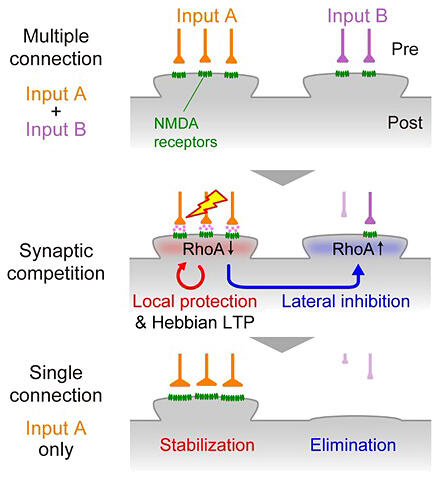In mammalian cerebral nerve circuits, synapses are formed in excess in early development, and then they are reorganized to form elaborate circuits in response to input from synapses. The reorganization process not only builds and strengthens the necessary neurites and synapses, but also prunes the unnecessary ones. The kind of synapses that are strengthened and survived has been identified previously, but the mechanism of synapse pruning remained unclear.
Professor Takeshi Imai, Assistant Professor Satoshi Fujimoto, Assistant Professor Marcus Leiwe (at the time of research) and Graduate Student Shuhei Aihara of the Graduate School of Medical Sciences at Kyushu University, Professor Tetsuichiro Saito of the Graduate School of Medicine at Chiba University, and their collaborators performed research and clarified the mechanism by which dendrites receive strong input signals to protect themselves and emit signals to promote the pruning of other dendrites. They also revealed the mechanism for the synaptic competition that leads to the selection of subjects for pruning. Clarifying the basic principle of pruning neural circuits is a landmark achievement that will appear in textbooks. The result was published in the academic journal Developmental Cell.

Provided by Kyushu University
Using mouse mitral cells as a model, the research group found that the input of glutamate released by spontaneous neuronal activity was necessary to facilitate mitral cell dendrite pruning. They found that glutamate, after activating N-methyl-D-aspartate (NMDA) receptors in dendrites, locally reduces the activity of the pruning molecule RhoA, whereas glutamate activates RhoA throughout the neuron to promote the pruning of the remaining dendrites. In other words, they revealed that the regulation of RhoA acts in lateral inhibition to protect only the synapses that receive input and weakens other synapses.
They also found that RhoA is essential for dendrite pruning among neurons in layer 4 of the barrel cortex of the cerebral cortex, suggesting that it is a universal mechanism in the reorganization of neural circuits.
Fujimoto said, "I have been working on this project for 12 years since I joined as a postdoc. I believe that I have successfully demonstrated the basic principles of neural circuit formation."
Imai stated, "Unless we know how brain circuits are formed, we cannot cure brain diseases. This time, we have proved this mechanism with two examples, and I believe that the same mechanism exists in other systems. In the future, we would like to study, for example, the transmission system and clarify its underlying mechanisms. We also plan to examine its relationship with diseases."
Journal Information
Publication: Developmental Cell
Title: Activity-dependent local protection and lateral inhibition control synaptic competition in developing mitral cells in mice
DOI: 10.1016/j.devcel.2023.05.004
This article has been translated by JST with permission from The Science News Ltd. (https://sci-news.co.jp/). Unauthorized reproduction of the article and photographs is prohibited.




